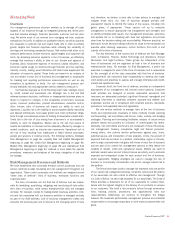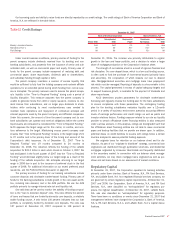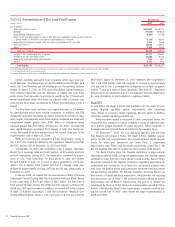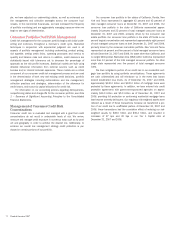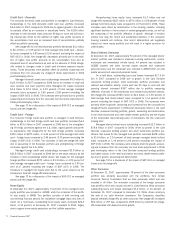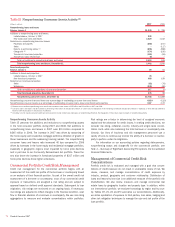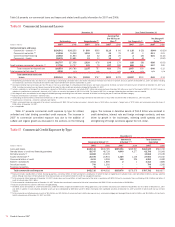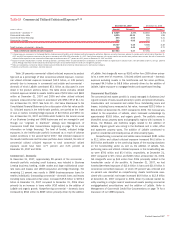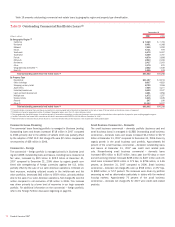Bank of America 2007 Annual Report Download - page 70
Download and view the complete annual report
Please find page 70 of the 2007 Bank of America annual report below. You can navigate through the pages in the report by either clicking on the pages listed below, or by using the keyword search tool below to find specific information within the annual report.
Table 12 Reconciliation of Tier 1 and Total Capital
December 31
(Dollars in millions) 2007 2006
Tier 1 Capital
Total shareholders’ equity
$146,803
$135,272
Goodwill
(77,530)
(65,662)
Nonqualifying intangible assets
(1)
(5,239)
(3,782)
Effect of net unrealized (gains) losses on AFS debt and marketable equity securities and net
(gains) losses on derivatives recorded in accumulated OCI, net-of-tax
(2,149)
6,565
Unamortized net periodic benefit costs recorded in accumulated OCI, net-of-tax
1,301
1,428
Trust securities
(2)
16,863
15,942
Other
3,323
1,301
Total Tier 1 Capital
83,372
91,064
Long-term debt qualifying as Tier 2 Capital
31,771
24,546
Allowance for loan and lease losses
11,588
9,016
Reserve for unfunded lending commitments
518
397
Other
(3)
6,471
203
Total Capital
$133,720
$125,226
(1) Nonqualifying intangible assets of the Corporation are comprised of certain core deposit intangibles, affinity relationships and other intangibles.
(2) Trust securities are net of unamortized discounts.
(3) Includes 45 percent, or $6.0 billion, of the pre-tax fair value adjustment related to the Corporation’s stock investment in CCB.
Certain corporate sponsored trust companies which issue trust pre-
ferred securities (Trust Securities) are deconsolidated under FIN 46R. As a
result, the Trust Securities are not included on our Consolidated Balance
Sheets. On March 1, 2005, the FRB issued Risk-Based Capital Standards:
Trust Preferred Securities and the Definition of Capital (the Final Rule)
which allows Trust Securities to continue to qualify as Tier 1 Capital with
revised quantitative limits that would be effective after a five-year tran-
sition period. As a result, we continue to include Trust Securities in Tier 1
Capital.
The Final Rule limits restricted core capital elements to 15 percent
for internationally active bank holding companies. In addition, the FRB
revised the qualitative standards for capital instruments included in regu-
latory capital. Internationally active bank holding companies are those with
consolidated assets greater than $250 billion or on-balance sheet
exposure greater than $10 billion. At December 31, 2007, our restricted
core capital elements comprised 20.3 percent of total core capital ele-
ments. We expect to be fully compliant with the revised limits prior to the
implementation date of March 31, 2009.
Table 12 reconciles the Corporation’s total shareholders’ equity to
Tier 1 and Total Capital as defined by the regulations issued by the FRB,
the FDIC, and the OCC at December 31, 2007 and 2006.
At December 31, 2007, the Corporation’s Tier 1 Capital, Total Capi-
tal and Tier 1 Leverage ratios were 6.87 percent, 11.02 percent, and 5.04
percent, respectively. During 2007, the Corporation completed its acquis-
itions of U.S. Trust Corporation for $3.3 billion in cash and LaSalle
for $21.0 billion in cash. As a result of these acquisitions, the Corpo-
ration’s Tier 1 Capital, Total Capital, and Tier 1 Leverage ratios were
reduced by approximately 130 bps, 145 bps and 90 bps, respectively, at
December 31, 2007.
In January 2008, we issued 240 thousand shares of Bank of America
Corporation Fixed-to-Floating Rate Non-Cumulative Preferred Stock, Series
K with a par value of $0.01 per share for $6.0 billion. The fixed rate is
8.00 percent through January 29, 2018 and then adjusts to three-month
LIBOR plus 363 bps thereafter. In addition, we issued 6.9 million shares
of Bank of America Corporation 7.25% Non-Cumulative Perpetual Con-
vertible Preferred Stock, Series L with a par value of $0.01 per share for
$6.9 billion. Based on December 31, 2007 balances, the Corporation’s
Tier 1 and Total Capital ratios are expected to increase by approximately
105 bps and its Tier 1 Leverage ratio is expected to increase by approx-
imately 75 bps as a result of these issuances. See Note 15 – Regulatory
Requirements and Restrictions to the Consolidated Financial Statements
for more information on the Corporation’s regulatory capital.
Basel II
In June 2004, the Basel II Accord was published with the intent of more
closely aligning regulatory capital requirements with underlying
risks. Similar to economic capital measures, Basel II seeks to address
credit risk, market risk and operational risk.
While economic capital is measured to cover unexpected losses, the
Corporation also maintains a certain threshold in terms of regulatory capi-
tal to adhere to legal standards of capital adequacy. These thresholds or
leverage ratios will continue to be utilized for the foreseeable future.
On December 7, 2007, the U.S. regulatory agencies published the
final Basel II rules (Basel II Rules). The Basel II Rules establish require-
ments for the U.S. implementation and provide detailed capital require-
ments for credit and operational risk under Pillar 1, supervisory
requirements under Pillar 2 and disclosure requirements under Pillar 3. We
are still awaiting final rules for market risk requirements under Basel II.
The Basel II Rules allow U.S. financial institutions to begin parallel
reporting as early as 2008. During the parallel period, the resulting capital
calculations under both the current (Basel I) rules and the Basel II Rules
should be reported to the financial institutions’ regulatory supervisors for
examination and compliance for at least four consecutive quarterly peri-
ods. Once the parallel period and subsequent three-year transition period
are successfully completed, the financial institution will utilize Basel II as
their means of capital adequacy assessment, measurement and reporting
and discontinue use of Basel I. We continue execution efforts to ensure
preparedness with all Basel II requirements. The goal is to achieve full
compliance by the end of the three-year implementation period in 2011.
Further, internationally Basel II was implemented in several countries dur-
ing the second half of 2007, while others will begin implementation in
2008 and 2009.
68
Bank of America 2007









